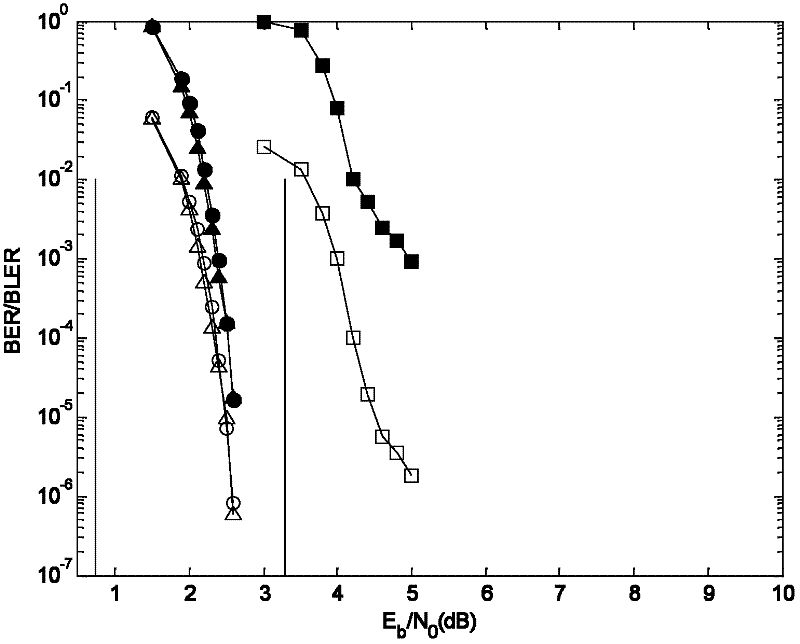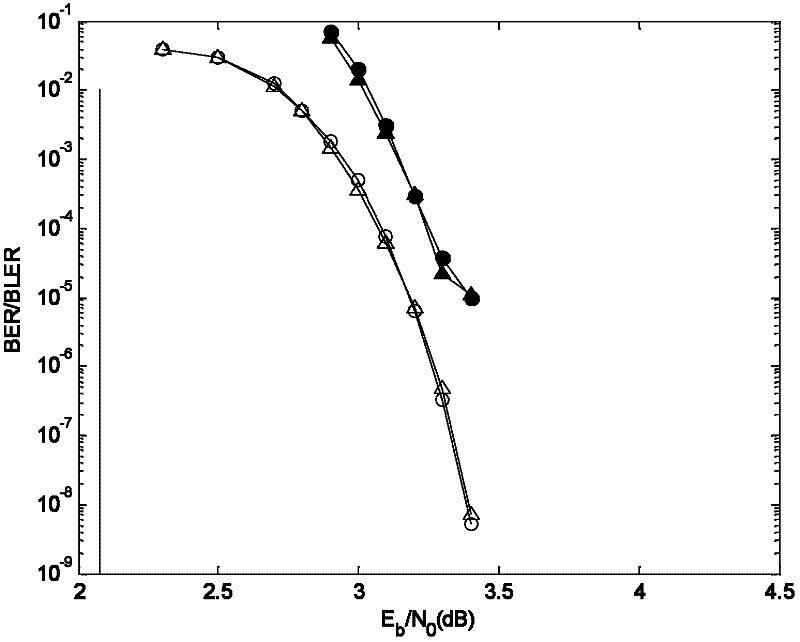Method for constructing quasi-cyclic low-density check code based on Euclidean geometry (EG)
A technology of a low-density check code and a construction method, which is applied in the field of construction of a quasi-cyclic low-density check code, can solve many problems, such as affecting decoding performance, and difficulty in further reducing the complexity of hardware implementation.
- Summary
- Abstract
- Description
- Claims
- Application Information
AI Technical Summary
Problems solved by technology
Method used
Image
Examples
Embodiment 1
[0037] In this example, the steps of the quasi-cyclic LDPC encoding method based on Euclidean geometry are as follows:
[0038] I, select Euclidean geometry EG (4,2 2 ), construct 21 sparse matrices, denoted as H 1 , H 2 ,…H 21 ,
[0039] EG(4,2 2 ) in all straight lines are divided into K=(2 3×2 -1) / (2 2 -1) = 21 cyclic classes. For 1≤k≤21, construct a sparse matrix H k , matrix H k Each column of is the associated vector of the line in the kth cycle class, H k is a 4×1 matrix array composed of n×n cyclic permutation matrices, randomly select a straight line in the kth cyclic class, and use the associated vector of the straight line as the matrix H k The first column of H k The rest of the columns are obtained by the piecewise cyclic shift of the previous column. Based on the correlation vector of straight lines in each cyclic class of Euclidean geometry, a sparse matrix H consisting of cyclic permutation matrices is constructed k , and 21 sparse matrices are obt...
Embodiment 2
[0049] I, select Euclidean geometry EG (4,2 2 ), construct 21 sparse matrices, denoted as H 1 , H 2 ,…H 21 ,
[0050] EG(4,2 2 ) in all straight lines are divided into K=21 cycle classes. For 1≤k≤21, construct a sparse matrix H k , matrix H k Each column of is the associated vector of the line in the kth cycle class, H k is a 4×1 matrix array composed of n×n cyclic permutation matrices, randomly select a straight line in the kth cyclic class, and use the associated vector of the straight line as the matrix H k The first column of H k The rest of the columns are obtained by the piecewise cyclic shift of the previous column. Based on the correlation vector of straight lines in each cyclic class of Euclidean geometry, a sparse matrix H consisting of cyclic permutation matrices is constructed k , and 21 sparse matrices are obtained.
[0051] II, 21 sparse matrices obtained in step I are used as sub-matrixes to construct the following matrix:
[0052] H ...
Embodiment 3
[0060] I, choose Euclidean geometry EG (5,2 2 ), construct 85 sparse matrices, denoted as H 1 , H 2 ,…H 85 ,
[0061] Will EG(5,2 2 ) in all straight lines are divided into K=(2 4×2 -1) / (2 2 -1) = 85 cyclic classes. For 1≤k≤85, construct a sparse matrix H k , matrix H k Each column of is the associated vector of the line in the kth cycle class, H k is a 4×1 matrix array composed of n×n cyclic permutation matrices, randomly select a straight line in the kth cyclic class, and use the associated vector of the straight line as the matrix H k The first column of H k The rest of the columns are obtained by the piecewise cyclic shift of the previous column. Based on the correlation vector of straight lines in each cyclic class of Euclidean geometry, a sparse matrix H consisting of cyclic permutation matrices is constructed k , got 85 sparse matrices.
[0062] II, 85 sparse matrices that step I gained are used as sub-matrixes to construct the following matrix:
[0063] ...
PUM
 Login to View More
Login to View More Abstract
Description
Claims
Application Information
 Login to View More
Login to View More - R&D
- Intellectual Property
- Life Sciences
- Materials
- Tech Scout
- Unparalleled Data Quality
- Higher Quality Content
- 60% Fewer Hallucinations
Browse by: Latest US Patents, China's latest patents, Technical Efficacy Thesaurus, Application Domain, Technology Topic, Popular Technical Reports.
© 2025 PatSnap. All rights reserved.Legal|Privacy policy|Modern Slavery Act Transparency Statement|Sitemap|About US| Contact US: help@patsnap.com



